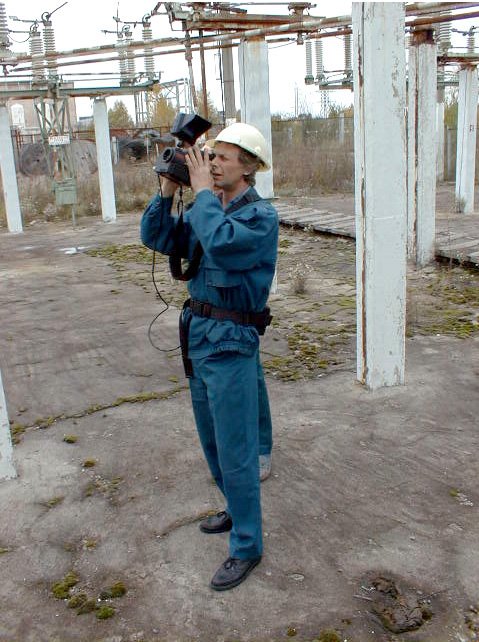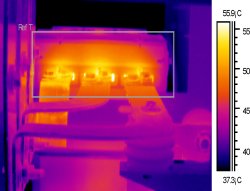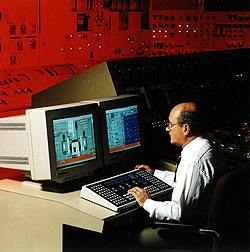Important Note: This website contains historical data from the INSP project. As of 2004 the site is no longer maintained and certain sections do not work correctly.
 |
Program Overview Page 5 of 8 |
 |
Key Accomplishments
Technology Transfer
U.S. and host-country organizations are conducting joint projects to manufacture safety equipment, perform safety assessments, and use advanced technology in staff training. After U.S. training, a Lithuanian company manufactured replacement modules for reactor control-and-protection systems. Through work with U.S. engineers, a company in Ukraine and another in Russia developed the capability to manufacture highly effective fire doors. The United States is transferring computer analysis codes and methodologies that enable host-country specialists to assess plant safety, identify risks, and set priorities for safety upgrades.
Training
With U.S. support, Russia and Ukraine each have established a successful nuclear training center to accelerate the transfer of skills and safety information. The instructors have developed and conducted job-specific maintenance and operations courses, along with courses in employee safety and supervisory skills.
The instructors now are working with U.S. training specialists to expand the training programs to other Ukrainian and Russian plants. Plant instructors are developing and conducting site-specific training courses.
U.S. training specialists also are working with instructors in Armenia, Bulgaria, Lithuania, and Slovakia to improve their training programs.
Simulator Development
Emergency Operating Instructions
Two plants with Soviet-designed reactors have implemented symptom-based emergency operating instructions--Ukraine's Chornobyl plant and Russia's Novovoronezh plant. Symptom-based instructions enable control room operators to stabilize a reactor quickly during an abnormal event. The time saved can prevent disaster.
U.S. specialists have transferred the skills for developing symptom-based instructions to pilot plants in Ukraine, Russia, and Central and Eastern Europe. U.S. and host-country specialists now are validating the instructions for use at Soviet-designed reactors.
Control Room Operator Prevents a DisasterIn spring 1995, a control room operator stopped a train of events at a Soviet-designed reactor that could have led to disaster. The operator had participated in an exchange visit to the United States, where he watched a crew respond to a hypothetical disaster on a plant simulator. The "accident" depicted loss of cooling water to the reactor core. The operator also had worked with U.S. specialists to develop symptom-based emergency operating instructions for controlling accidents at his own plant. Then, during routine testing at his plant, a valve for the reactor cooling system stuck open. The system rapidly depressurized. Cooling water stopped flowing to the reactor core. Operating crews tried to determine the cause of the crisis in order to restore the flow of cooling water. They were unsuccessful, and the nuclear fuel began to overheat. The operator who had worked with U.S. specialists intervened. Based on his knowledge of emergency operating instructions and his experience watching a U.S. crew deal with a similar situation during simulator training, he decided to use reactor head vents to restore cooling. Water returned to the reactor core, and the plant was brought to cold shutdown. The abnormal event ended before fuel damage occurred. |
Safety Maintenance Technologies
The United States has supplied up-to-date tools and training for maintenance workers at the five plants with RBMK reactors. The workers now maintain crucial piping systems with pipe lathe/weld-preparation machines, valve-seat resurfacing equipment, and vibration monitoring and shaft alignment systems. They use ultrasonic and other nondestructive examination equipment to find flaws in pipes and other key reactor components.
Preventive maintenance workers at Bulgaria's Kozloduy plant and Ukraine's Chornobyl plant are using infrared thermography cameras to detect faulty components, "hot spots," and cold connections in electrical and instrumentation and controls systems. In addition, workers at the Chornobyl plant and Lithuania's Ignalina plant are using advanced equipment to detect the onset of insulation breakdown in the main generator and high-voltage wiring, preventing fires and potential system failures.
 |  |
 | |
| Technicians use a U.S.-supplied infrared thermography unit to detect hot spots in electrical systems before equipment fails. | The infrared camera clearly shows hot spots in this electrical junction (top) that are not visible otherwise (bottom). The equipment is being used at the Chornobyl plant. |
Engineered Safety Upgrades
 |
| Control room operators at four plants in Ukraine and two in Russia now have safety parameter display systems, which enable them to assess abnormal conditions quickly and take corrective actions. |
Control room operators at four plants in Ukraine and two in Russia now have safety parameter display systems, which enable them to assess abnormal conditions rapidly and take corrective actions. Development of systems for seven other Soviet-designed reactors is under way.
With U.S. support, Kola staff have substantially reduced leaks in the radiation confinement system. Lithuania's Ignalina plant has received reliable replacements for the aging modules in its electronic control-and-protection system. With U.S. support, a new backup control-and-protection system has been installed at Ignalina Unit 1. U.S. and host-country experts have defined methodologies for conducting safe-shutdown analyses at Soviet-designed reactors, and pilot analyses are under way at Ukraine's Zaporizhzhya plant and Russia's Smolensk plant.
Safety Projects at Bilibino
Russia's extremely isolated Bilibino plant has had difficulty retaining skilled workers, finding replacement parts, and communicating reliably with the outside world. Nome, Alaska, is just 850 miles and predominantly downwind from Bilibino. The North Slope of Alaska is directly downwind of the plant. With U.S. support, the plant will install a satellite-based communications device early in 1999. The device will serve as an early-warning system while giving plant personnel the ability to exchange maintenance and safety information regularly with U.S. and Russian personnel. U.S. training specialists are working with Bilibino instructors to improve training programs, and the United States is supplying high-priority maintenance equipment.
Spent-Fuel Storage
Configuration Management
With support from U.S. specialists, Bulgaria's Kozloduy plant and Lithuania's Ignalina plant have established configuration management programs. Configuration management ensures proper documentation and control of a plant's safety design basis. It also ensures that plant operators can rely on the accuracy of drawings and documents they use in making operating decisions. U.S. specialists are supporting the development of configuration management systems at the Zaporizhzhya plant in Ukraine and the Novovoronezh plant in Russia.
Regulatory Capabilities
Regulatory experts from Ukraine and Russia have participated in extensive training with U.S. experts, developing capabilities for effective oversight of nuclear power plants.
Chornobyl Initiatives
Addressing an urgent safety concern, workers have stabilized a ventilation stack damaged by the 1986 accident at Chornobyl. The repairs marked the first resolution of a significant safety problem stemming from the disaster. The Ukrainian contractor completed the work on schedule, demonstrating Ukraine's ability to manage and perform high-quality work under an international contracting arrangement. U.S. specialists provided technical support that minimized worker exposure to the high radiation levels around the stack. The United States, Canada, and Ukraine funded the project.
Ukrainian and international specialists have begun carrying out the Shelter Implementation Plan, which aims to prevent collapse of the shelter around the ruined reactor Unit 4, construct a new shelter to cover the current one, and protect workers and the environment. U.S. specialists provided the primary technical support for developing the plan. The United States has provided shelter workers with equipment and training to reduce their radiation exposure, improve industrial safety, and suppress the radioactive dust inside the shelter.
U.S. personnel are working with Ukrainian specialists to develop technical strategies for shutting down and deactivating the Chornobyl plant. The United States also is working with Ukraine to complete the construction of a new heating plant. A new heat source must be available to maintain safety systems at Chornobyl when deactivation begins (more information on heat plant).
Joint projects in data analysis, spent-fuel management, and reactor closure are under way at the International Chornobyl Center for Nuclear Safety, Radioactive Waste and Radioecology, established in 1996 in Kyiv. Ukraine also established the center's Slavutych Laboratory in 1996 in the town of Slavutych, near Chornobyl. The United States has supported development of the center and has provided a satellite communications system, which gives the center reliable telephone access to the rest of the world, as well as videoconferencing capability and electronic access to the information databases of partnering organizations. U.S. personnel have provided training for center staff in management skills and the evaluation of nuclear-related technologies.
The United States and Ukraine have agreed to create the International Radioecology Laboratory as a new subsidiary of the International Chornobyl Center. The laboratory will facilitate Ukrainian and international research on the effects of radiation on plants and animals.
| Summary | Key Accomplishments | ||
| Introduction | Performace Measurement and Future Directions |
||
| Historical Issues and Reactor Types | Timeline | ||
| Reducing Risks | Contacts |
 |
Program Overview Page 5 of 8 |
 |